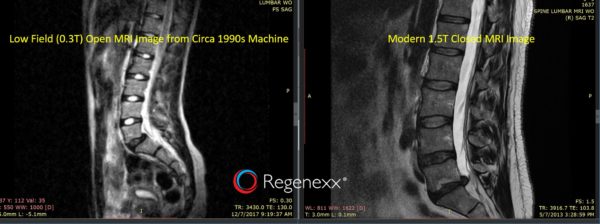Getting the Right MRI: What Your Doctor Won’t Tell You

©Regenexx
One thing that surprises patients is that there can be huge differences in the quality of MRIs. I experienced this yesterday when performing a phone review with a patient. The MRI I was presented with had an image quality that was circa 1990. Since we see this from time to time, I thought it was time for a blog.
What Is an MRI?
To understand the biggest difference between a good and a bad MRI, you have to understand that an MRI works via a magnetic field. This means that a huge magnet aligns all of the atoms of a certain type in your body. The magnet is then turned off and the atoms shift back to their original orientation. When they do this, they generate a radio pulse that is picked up by the machine, and this complex data is assembled into an image by a computer.
These are very powerful magnets that are measured in units named after the genius inventor of the turn of the century, Nikolai Tesla. One “Tesla” is equivalent to the magnetic field strength of the entire earth. The higher the magnetic strength of the magnet in the MRI, the better the image.
Tesla Numbers, and Fuzzy vs. Sharp Pictures
Take the images of the low back above. They are both sideways slices called sagittal views. As you can see, the one on the left is fuzzy and the one on the right is sharp. If you remember old cell phone pictures, the one on the left looks more like a picture from an old cell phone. If you try to magnify it, you end up seeing a very fuzzy image. On the right, the image is much sharper, like a modern cell phone picture. If you try to magnify it, you still see nice detail.
What’s the difference? The image on the right was taken with an MRI that has five times the Tesla strength as the image on the left. The left MRI was taken with a 0.3T (T is for Tesla) magnet, and the one on the right was taken with a 1.5T magnet. The image on the left gives me far less information about what’s going on with the back, while the image on the right provides more information.
The Inexpensive MRI Insurance Scam
What’s insane about the two images above is that both are reimbursed the same by insurance companies. Your co-pay and deductible are also likely to be the same. Despite this, the machine that took the image on the left could likely be bought right now for free as long as you pay to move it. Buying the machine on the right will run a clinic or hospital about 1–1.5 million dollars. So do your homework, as you can get both for the same price through insurance.
Open vs. Closed MRI Machines
There are two types of MRI-machine formats: open vs. closed. Open units have two large surfaces juxtaposed and allow the patient to look to the left or right and see the room. If they’re upright machines where the patient sits in the machine, the patient can look out toward the room. Closed machines have a tube that the patient is moved slowly into and out of. The open machines are less claustrophobic but also have far weaker magnets and produce images that aren’t as sharp as closed machines. While some of the newer open machines have narrowed the imaging-quality gap, the closed machines still produce better images. The worst images are produced by the older open machines, like our 0.3T image above.
What You Should Do When Booking an MRI
All you need to do is ask. Inquire about the Tesla field strength of the magnet. If it’s a 0.3T open, then avoid these machines. There are newer open systems that produce better images that are closer to closed machines, and these are typically in the 0.6T range. The “gold standard” is a closed machine with a 1.5T magnet. These are very common out there and should be easy to find. The best possible machine is a 3.0T, but these are a bit harder to find as they’re still very expensive machines.
If you’re claustrophobic, consider asking your doctor for a sedative like Valium or Xanax. If that won’t work, then look for a 0.6T open machine. Again, avoid the 0.3T open MRIs!
The upshot? Making sure that the doctor doesn’t miss something on your MRI is important. As I’ve blogged before, a common-sense thing to look for is a physician who reads the MRI in front of you in the office. If your doctor just relies on the report, that’s not a good sign. Next, picking the right MRI machine is also critical, as your doctor can see much more on a sharp image than he or she can see on a fuzzy one!
If you have questions or comments about this blog post, please email us at [email protected]
NOTE: This blog post provides general information to help the reader better understand regenerative medicine, musculoskeletal health, and related subjects. All content provided in this blog, website, or any linked materials, including text, graphics, images, patient profiles, outcomes, and information, are not intended and should not be considered or used as a substitute for medical advice, diagnosis, or treatment. Please always consult with a professional and certified healthcare provider to discuss if a treatment is right for you.